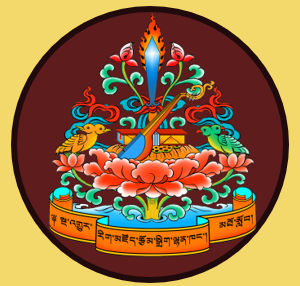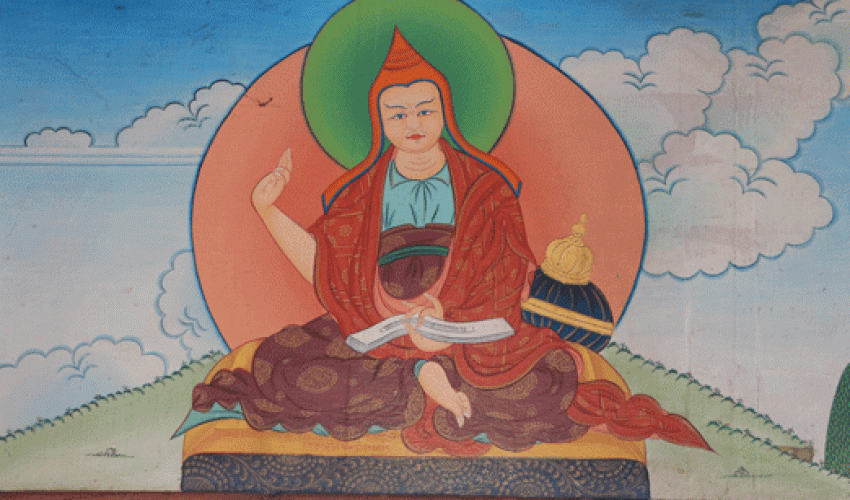Acharya Vasubandhu was born to a brahmin family one year after the noble master Arya Asanga became a fully ordained monk. They were brothers born to the same mother. Some Tibetan scholars consider Vasubandhu to be the twin brother of Arya Asanga while some believe he was his Dharma brother. Vasubandhu was also said to have been prophesied to practice the rituals of sharpening the mind, to hear more and to accomplish meditative concentration like his brother Asanga had been prophesied to. He became a monk at Nalanda University and perfected the three scriptural collections of the shravakas. In order to master the ultimate meaning of Abhidharma, to study the tenets of the eighteen Vinaya schools of the shravakas, and to become perfect in logic he went to Kashmir and relied upon Samghabhadra, a Vaibhashika master, as his main teacher. He became erudite by studying both Buddhist and non-Buddhist philosophies. He dwelled in Magadha for many years, distinguished between logical and illogical establishment, and taught all the scriptural collections of the shravakas to devoted disciples.
While he was returning back towards the central part of Magadha, none of the robbers or yakshas could hinder him. There, he taught intensive logic for a few years to many spiritual communities of shravakas. At that time, when he saw his brother Asanga’s ‘five treatises on the ground’—the Ground of Yogic Practices, the Compendium of Bases, the Compendium of Enumeration, the Compendium of Ascertainment, and the Compendium of Explanation—being unable to understand such Mahayana teachings, he disbelieved the fact that his brother had received these teachings from the supreme deity, Maitreya. Thus, he satirically spoke the following words:
Alas! Asanga stayed in the forest
For twelve years practicing meditative stabilization.
Instead of achieving this, he composed
Enough philosophical treatises to load an elephant.
Asanga heard about this and realized that it was an appropriate time to tame him. He commanded a monk to memorize the Sutra of Inexhaustible Intellect (Akshayamatinirdesha Sutra) and another monk the Sutra of the Ten Stages(Dashabhumika Sutra). Then Asanga told them to recite these before Vasubandhu once they were thoroughly memorized. In the evening when the first monk recited the sutra for Vasubandhu, he was moved by the law of causes taught in the Mahayana but wondered if the fruition was ideal or not. Then, early in the morning when the other monk recited the second sutra, Vasubandhu realized the excellence of both the cause and effect in the Mahayana. Out of great regret for committing negative actions and deprecating the teachings, he searched for a knife and attempted to cut off his own tongue, but the two monks stopped him. They requested Vasubandhu to go before Asanga and confess instead of cutting off his tongue, because Asanga had a special method for purification, and so he went.
According to Tibetan historians, it is well-known that Vasubandhu studied all the Mahayana teachings and discussed them with his brother. While discussing them, though Vasubandhu was more intelligent, Asanga always had excellent answers. Vasubandhu asked him the reason for this. Asanga replied that his answers were taught to him by the supreme deity. Then Vasubandhu requested that he show him the deity’s face, but Asanga replied that he didn’t have the fortune to see the deity in this life. However, he showed Vasubandhu methods to purify unwholesome deeds.
Indian historians dispute this account and prove it illogical. They assert that the fortunate Mahayana students of the past did not argue with their own master nor did they copy or explain certain methods without getting permission from their teacher. Even Vasubandhu said that he didn’t want to debate with Samghabhadra, they argue, so how is it possible for him to have debated with Asanga? It is also unacceptable that Asanga received the teachings from Maitreya whereas Vasubandhu unknowingly asked him about it and Asanga too directed him to receive the teachings from the supreme deity as if Asanga didn’t know.
Indian historians say that when Vasubandhu requested Asanga for a method to purify his negative actions, Asanga asked Maitreya about this matter, whereupon Vasubandhu was told to explain the Mahayana teachings extensively, to compose commentaries on numerous collections of sutras, and to recite one hundred thousand secret mantras of Ushnisha Vijaya. He then realized the complete meaning of the collection of the Mahayana sutras at once when he received them from Asanga. He received empowerment from a mantra specialist, recited the five hundred retention sutras, and accomplished the recitation of the secret mantra of Vajrapani. He realized the profound meaning and acquired extraordinary meditative stability.
During that time, Vasubandhu realized the complete meaning of all the Buddha’s teachings that exist in this world and became renowned to be the only one to have received that much of the teachings after the Buddha’s mahaparinirvana.
Among the Shravaka Tripitaka, Vasubandhu learned each of the five hundred sutras, containing a total of three hundred thousand stanzas; the collection of the forty-nine sutras in the Ratnakutasamaja; the Avatamsaka Sutra; and the Samajaratna Sutra. Besides these he learned the five hundred large and small Mahayana sutras like the Prajnaparamita-sata-sahasrika, and also five hundred dharanis. He profoundly realized all the words and meanings of these teachings. Sitting in a pool of sesame oil, he would recite all these teachings annually for fifteen days and nights. He could recite the Prajnaparamita Sutra in Eight Thousand Lines daily within an hour or two.
When Vasubandhu entered the Mahayana, five hundred learned shravaka upholders also joined. After Asanga passed away, Vasubandhu became the main abbot of Nalanda. According to the different interests of people, he recited various religious works, conferred novice and full ordination vows, and taught the fully ordained monks, engaging in the tenfold duties to self and others without any downfall. He continuously taught different Mahayana sutras, dividing them into twenty sessions a day. He would extract the essence of the teachings and memorize the texts. He would himself receive teachings from his sublime deity at midnight while sleeping. At dawn he would abide in authentic meditative equipoise. In the time in between sessions, he composed commentaries and refuted the views of non-Buddhists, writing about fifty commentaries on other texts like the textual corpus of the prajnaparamita, the Sutra of Inexhaustible Intellect (Akshayamatinirdesha Sutra), the Sutra of the Ten Bhumis, the Triratna Anusmriti Sutra, the sutra of five mudras, the sutra of dependent origination, the Ornament of the Mahayana Sutras, the two other texts composed by Maitreya, and so on, regardless of whether they were from higher or lower vehicle.
Vasubandhu composed a large number of scriptures, including the Verses on the Treasury of the Abhidharma (Abhidharmakosha), the Explanation of the Five Aggregates (Panchaskandhaprakarana), a treatise on karma (Karmasiddhiprakarana), Rules for Debate (Vyaakhyayukti), Instruction on the Amitabha Sutra (Amitayus Sutropadesha), a commentary on the Ten Stages Sutra (Dashabhumikabhaasya), a commentary on the Sutra of Inexhaustible Intellect, a commentary on the Diamond Cutter Sutra (Vajrachhedika Prajnaparamita Sutra), a commentary on the Lotus Sutra (Saddharma Pundarika Sutra), Paramarthasaptati, a critique of Samkhya, and so on.
Vasubandhu didn’t travel to any distant lands. Instead he mostly resided in Magadha, nurturing the slightly deteriorated old religious institutions, and establishing one hundred and eight Mahayana dharma centres across Magadha. When he went to Gaudha in the east, he expounded on the sutras to countless people of that region. As a result gods showered down a rain of golden flowers and even the lowliest beggars got a huge share of golden flowers. Another one hundred and eight dharma centres were established in that region too. At the invitation of Brahmin Makshika of Odhivisha, Vasubandhu performed ceremonies for three months with twelve thousand members of the Mahayana sangha, whereby five precious gems sprung up spontaneously in that house. The brahmins, householders and the king of that region generated faith in him, and he established one hundred and eight dharma centres there.
Likewise in the region of the southern direction and others, it is said that he ordered them to establish dharma centres almost equal to the original ones in Magadha itself. He was renowned for establishing six hundred and fifty-four dharma centres in total. The Mahayana sangha of his time was even greater than that of Arya Asanga; there was a total of around sixty thousand monks from all over the region. There were about one thousand fully ordained monks who followed and resided with Vasubandhu all the time, who were all highly learned and endowed with pure moral discipline.
Wherever Vasubandhu dwelled, there used to appear non-humans who offered various items, and who caused sources of precious gems to spring up continuously. He would declare the truths about the result of virtuous and non-virtuous actions through his clairvoyance when he was asked about it. Moreover, when the city of Rajagriha caught fire, he extinguished it by reciting a solemn prayer of powerful truth; he also brought under control an epidemic that had spread in the city of Jananta. By the power of vidya-mantras he controlled his own longevity. After defeating around five hundred extremist opponents, generally he converted a total of about five hundred thousand extremists and brahmins to Buddhism.
Later Vasubandhu went to Nepal with a thousand disciples and established dharma institutions, thereby increasing the sangha communities innumerably. Finding an ordained monk ploughing a field while wearing his monk’s robe made him depressed and he said, “The buddhadharma has degenerated.” So, he started teaching in the midst of the sangha community, recited the secret dharani of Ushnisha Vijaya three times in reverse, and entered into mahaparinirvana. It was proclaimed that the sun of the Dharma had set for the time being. His disciples built a stupa there.
According to the Tibetan history, it is said that Vasubandhu sent his root text of the Abhidharmakosha to Samghabhadra in Kashmir. That made Samghabhadra pleased but this turned into displeasure when the commentary was actually shown to him. He set off for Magadha to debate with Vasubandhu, but Vasubandhu had already left for Nepal by then.
Vasubhandu lived nearly one hundred years, benefitting beings and rendering service to the buddhadharma for about twenty-five years after the demise of his brother Asanga.
By Tenzin Dorji
Final Year, NNI



